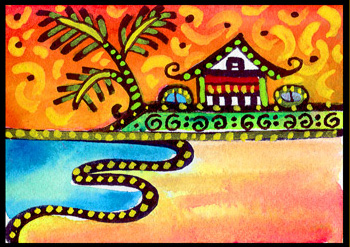Updated: September 13, 2007
A few months ago, my nephew Russell had just started the Somersize program, and asked me, "Can you eat meat with beans?" As I answered him with a resounding "No!" I realized that what has become second nature to me -- no, you can't eat Proteins and Fats (meat) with Carbos (beans) -- takes newcomers a little while to understand. So here are the top ten most common Somersize questions. 1. Should I eat more Proteins/Fats meals or Carbos meals? My recommendation is that for breakfast you usually have Breakfast 3 -- Fruits, then Carbos. For lunch, choose either Lunch 1 -- Carbos and Veggies -- or Lunch 2 -- Proteins/Fats and Veggies. At dinner you're probably better off having Dinner 2 -- Proteins/Fats and Veggies -- because you don't need the energy from carbohydrates that late in the day, and if you regularly eat carbohydrates at night and don't use the energy, they get stored as fat for later use. This is only a blueprint of how I divide my Proteins/Fats and Carbos meals -- you may find that your body can handle more carbohydrates and that you feel better eating mostly grains and vegetables. For me, those carbohydrates tend to stick to my hips when I eat them too often. On the other hand, if you are eating mostly Proteins/Fats meals, make sure to round them out with plenty of fresh vegetables. Watch your fat intake, and don't get excessive with the protein you eat because too much can be hard on your system. 2. I can eat fat and still lose weight? This sounds too good to be true.
Even though I always stress that you can choose to have either Carbos or Proteins/Fats at every meal, people often ask me if it's better to choose one over the other. In general, I find that the fewer carbohydrates I eat, the more weight I lose. Carbohydrates are an energy source, and if you're not giving your body any sources of energy, it has no choice but to break down your fat reserves for energy. But it's important to incorporate some Carbos because they have a lot of good fiber and help keep your system moving properly. I like to have a Fruits, then Carbos breakfast, and there are so many great choices. For lunch or dinner, I find more options with Proteins/Fats and plenty of Veggies. Carbos meals for lunch and dinner are a little more restrictive because you can have absolutely no fat.
As long as you are properly combining, you can eat moderate amounts of fat and still lose weight. When you combine fats with carbohydrates, it can upset your digestive system. For instance, if I ate a grilled ham and cheese sandwich, I would feel bloated and uncomfortable. But if I ate the ham and cheese without the bread -- with some fresh grill vegetables, for example -- I would feel satisfied and healthy.
How about cholesterol? Foods of animal origin -- such as meats and butters -- are generally high in cholesterol, and should be eaten in moderation. That's common sense. I know one person who heard about Somersizing from a friend, but didn't understand the whole program. Some of the meals he ate consisted of six eggs, half a pound of bacon and a side of broccoli smothered in cheese sauce. He was very careful not to eat any carbohydrates with the meals, and he lost eighteen pounds in six weeks! But this guy's cholesterol level increased by 50 points! This is not a smart way to Somersize.
3. How should I order when I eat out at a restaurant?
I realize this information may seem a bit overwhelming at first, but soon you will discover how simple Somersizing can be. So many people tell me, "I eat out two of three meals a day in restaurants; it's impossible to lose weight." Once you understand Somersizing, eating in restaurants is truly easy.
First I scan the menu and decide if I want a Proteins/Fats and Veggies meal or a Carbos and Veggies meal. The key to the Proteins/Fats meal is no bread, pasta, rice or potatoes. Some quick tips:
You may have to grill your server a little to get the information you need. (I have a friend who tells the server she's diabetic to make sure he really checks for sugar.)
The Level One Carbos meal is a little more restrictive when eating out. It must be fast-free so all the carbohydrates are burned off. For Carbos meals:
4. What happens if I skip a meal?
Don't do it! Whether you're eating at home or dining in restaurants, make sure you do not skip meals. Your mother always told you breakfast was the most important meal of the day, right? You're body's been fasting since you went to sleep, so when you wake up in the morning, you have gone for some eight to 10 hours without food. If you skip breakfast and don't eat until lunch, your body has gone for 12 to 14 without food. When you finally eat lunch, your body's survival instinct kicks in. it doesn't know when you're going to feed it again, so it hangs on to every morsel instead of properly processing the food. Remember to eat at least three meals a day -- or as many as six mini-meals, if you prefer.
5. Can I Somersize part of the time and eat as I'm used to the rest of the time?
As long as you are following all the Level One guidelines, you can eat until you are satisfied and full and still lose weight. But you cannot Somersize half-heartedly in the beginning. Your body is being retrained to burn your fat reserves. Don't confuse it by slipping up with bad combinations or Funky Foods.
6. I'm a vegetarian. What are my options on the Somersize program?
It's a little tougher to eat vegetarian on the program because so many of the easiest meals include a protein like chicken or fish. But you can make wonderful Carbos meals out of whole wheat pasta or brown or wild rice and vegetables. You can also cook with rice and beans -- good protein sources, although we include them in the Carbos group -- or add tofu to fresh vegetables. Use textured vegetable protein to make burgers; add it to chilis, soys and sauces. Vegans can have rice milk (not soy milk) on their carbo breakfast meal.
7. I like to put milk in my coffee. Is that OK?
As you know, whole milk and low-fat milk are Funky Foods and are not allowed on the Level One program. The only kind of milk you can have in nonfat (skim) milk, which is categorized as a carbohydrate because it has no fat. Therefore, you may have nonfat milk in your decaf coffee when you are having a Carbos meal or a Carbos and Veggies meal -- but not with a Proteins/Fats meal or Proteins/Fats and Veggies meal. I know it sounds strange, but you should use cream in your coffee when you are having proteins because cream can be digested more easily with proteins.
8. I love eating pasta, but I'm having a hard time eating it on Level One with no fat. Any suggestions?
On Level One, you have to make some adjustments when you eat pasta, but you don't have to eliminate it altogether. First, you must find whole-grain pasta and then top it with a sauce that contains no oil, butter or cheese. You probably will have a difficult time eating Level One pasta meals in restaurants, but it is possible to make your own sauce with no added fat.
When you make your nonfat sauce, start by sautéing your onions and garlic in a little tomato juice rather than in olive oil. Then add fresh or canned tomatoes and any of your favorite steamed or grilled vegetables with plenty of fresh herbs. Or try whole-grain pasta with fresh vegetables and soy sauce. It's delicious!
9. I crave desserts. What can I eat on Level One to satisfy my sweet tooth?
If you are used to eating a lot of sugar, you may go through a period of withdrawal when you begin Level One. Fruit is a natural form of sugar that will help you satisfy your cravings. Look for fruit sorbets or fruit popsicles sweetened with only fruit juice. Just make sure you wait two hours after your last meal before you have any fruit.
10. What do I do when I am having dinner at someone's house?
I'm sure you will be so excited about your new lifestyle that you will love sharing it with your hosts and other dinner guests. However, if you don not care to advertise your new way of eating at a dinner party, you can usually disguise your eating habits without offending your hosts.
Put the passed bread on your plate and break it into two pieces. No one will notice that you haven't eaten any. Your salad course is almost always Somersized; just eat around the carrots. Usually, dinner is some type of meat or fish served with rice, pasta, potatoes or vegetables. Eat the entrée with the exception of the carbohydrates and you will have no problem.
The most difficult situation comes when you are served some type of casserole or pasta made with white flour and bad combinations. Just eat a small portion and get right back on Level One the following day. As far as dessert, most hosts will understand if you pass.







